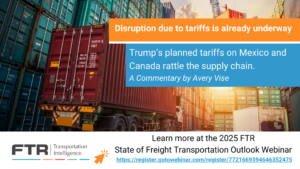Leaders of aftermarket parts businesses speaking at Heavy-Duty Aftermarket Dialogue are predicting more of the same for the year ahead, but are hopeful that increased stability seen in the back end of 2023 is a sign of things to come.
Houman Kashanipour, CEO and president of Alliant Power said it was a tale of two years in 2023, with a continuation of chaos and challenging conditions in the first half of the year, followed by a settling in the fourth quarter.

Traci Melville, president, North American Commercial Vehicle and Aftermarket Group with Eaton, said last year was about positioning for success this year.
“We, as a business, made investments in the business in terms of capacity from a manufacturing perspective, supplier availability headway and investments in people. I’m excited about seeing the rubber hit the road in that regard,” she said.
But she also has concerns, mostly around ongoing parts shortages and uncertainty about the U.S. election. Kashanipour said concerns he has carrying over into 2024 are mostly around pricing and inflation costs, and how to manage them.
‘Cautiously optimistic’
Ken Hogan, vice-president and general manager of Cummins-Meritor said he’s going into the year “cautiously optimistic,” largely because the U.S. and world economies continue to be strong. What worries him are geopolitical tensions and cybersecurity threats.
Each panelist acknowledged supply chain challenges are improving, but issues continue to arise. Melville added transparency and communication are vital to mitigating those risks.
“There is nothing to lose about going to a customer and being really transparent about inflation pressures your business is seeing,” she said, “whether that be in-house labor costs or external material costs. Being transparent lends a level of credibility. Our suppliers should feel like they’re a part of our business; when we succeed, they succeed and vice-versa.”
Working together with suppliers can bring solutions that wouldn’t have been possible for a company to develop on its own.
“Every week there is some new supplier in distress for whatever reason,” said Melville.
Finding the labor to meet demand is one ongoing challenge facing parts suppliers. At Eaton, the company is looking to embrace artificial intelligence (AI) and automation so it can keep employees working on the more satisfying elements of the job, while automating redundant or boring tasks.
“The competition for people is really fierce,” added Hogan. “People are also tired. They really worked hard the last three to four years because of all the disruptions.”
Labor shortage ‘no excuse’
Melville added, “It’s really important to understand your wage competitiveness,” though she added that’s just one element of employee satisfaction. Earlier in the day, Shannon O’Brien, senior director, programing and strategy with MEMA Aftermarket Suppliers shared results of a confidential survey of top-level executives that revealed they’re tired of hearing about labor issues as an excuse.
“This is the one they still hear a lot of in regards to supply chain, and they just don’t want to hear it anymore,” O’Brien said. “It may not reflect well on your business in their minds when they hear labor issues. It’s simply not an acceptable excuse anymore.”
“We have to do better,” admitted Hogan of the industry’s ability to maintain a reliable and talented workforce.






